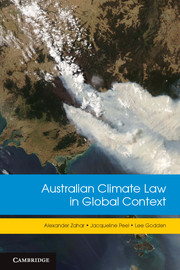Book contents
- Frontmatter
- Contents
- Acknowledgments
- Abbreviations and definitions
- Figures, tables and boxes
- Table of cases
- Table of statutes
- Table of treaties and other international instruments
- Introduction
- 1 Climate law
- 2 Legal elements and ongoing development of the international climate change regime
- 3 Measurement and verification of state emissions and legacy of the Kyoto Protocol’s compliance system
- 4 Development of climate law in Australia
- 5 Putting a price on carbon
- 6 The regulatory network of the Clean Development Mechanism
- 7 The emerging scheme for the protection of forests in developing countries (REDD)
- 8 Climate finance, technology transfer and capacity-building for sustainable development
- 9 Legal and regulatory frameworks for transition to a low-carbon economy
- 10 Biosequestration and emission reduction regulation in the Australian land sector
- 11 Adaptation to climate change through legal frameworks
- Postscript
- Bibliography
- Index
- References
2 - Legal elements and ongoing development of the international climate change regime
Published online by Cambridge University Press: 05 December 2012
- Frontmatter
- Contents
- Acknowledgments
- Abbreviations and definitions
- Figures, tables and boxes
- Table of cases
- Table of statutes
- Table of treaties and other international instruments
- Introduction
- 1 Climate law
- 2 Legal elements and ongoing development of the international climate change regime
- 3 Measurement and verification of state emissions and legacy of the Kyoto Protocol’s compliance system
- 4 Development of climate law in Australia
- 5 Putting a price on carbon
- 6 The regulatory network of the Clean Development Mechanism
- 7 The emerging scheme for the protection of forests in developing countries (REDD)
- 8 Climate finance, technology transfer and capacity-building for sustainable development
- 9 Legal and regulatory frameworks for transition to a low-carbon economy
- 10 Biosequestration and emission reduction regulation in the Australian land sector
- 11 Adaptation to climate change through legal frameworks
- Postscript
- Bibliography
- Index
- References
Summary
Introduction
This chapter undertakes a close examination of the key provisions of the UN Framework Convention on Climate Change and the Kyoto Protocol, reflecting on the significance of these provisions and their links with broader climate change issues. For twenty years the UNFCCC has defined the international climate change regime. It will probably retain this role for many years to come. While it lacks the specificity of the Kyoto Protocol in the critical area of emission reductions, its ongoing role as a ‘framework’ for international cooperation is generally accepted. A careful study of the Convention is still a requirement for understanding the present state of the international negotiations and the international law on climate change. As the Kyoto Protocol’s fortunes have diminished, the UNFCCC has reasserted itself as the treaty of greatest consequence. While the Convention will certainly outlast the Protocol as an operative treaty, the Protocol also repays close study, both for the governance model it represents and for the institutions it has created.
Background to the UNFCCC
Work on an international climate change convention began in 1988 with the creation of the Intergovernmental Panel on Climate Change by the World Meteorological Organization and the UN Environment Programme. The work of the IPCC underpins not only the science but also the law of climate change. In December 1988, the UN General Assembly endorsed the IPCC as an institution ‘to provide internationally co-ordinated scientific assessments of the magnitude, timing and potential environmental and socio-economic impact of climate change and realistic response strategies’.
- Type
- Chapter
- Information
- Australian Climate Law in Global Context , pp. 52 - 91Publisher: Cambridge University PressPrint publication year: 2012

